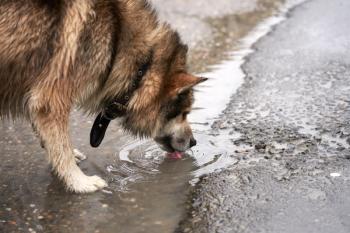
Foot-and-mouth disaster
National Report - Re-emergence of foot-and-mouth disease (FMD) on American farms may be inevitable, reports a public health expert.
NATIONAL REPORT — Re-emergence of foot-and-mouth disease (FMD) on American farms may be inevitable, reports a public health expert. Large-scale farming operations, unrestricted animal movement and a shortage of public health and large-animal veterinarians could be creating a perfect storm.
Former California state veterinarian Dr. Richard Breitmeyer says if the virus returned to the United States, it would quickly and easily become a billion-dollar catastrophe.
Michele Constantini/Getty Images
"We believe the risk is very real. It's almost been amazing, to be honest, that we've never had an incursion," says Breitmeyer, who served as California's state veterinarian for the last 17 years and now oversees the California Animal Health and Food Safety (CAHFS) Laboratory System at the University of California-Davis.
Thirty-two countries, mainly throughout parts of Africa and Asia, have reported cases of foot-and-mouth disease over the last year, according to the World Organization for Animal Health (OIE). Turkey reported the most outbreaks—261 total—in 2010, but Korea's outbreaks have probably garnered the most attention. With vaccines prohibited at the time of the outbreak, OIE says 10 cases of FMD were confirmed in June 2010, and all susceptible swine—9,000 in all—were destroyed. Other recent outbreaks were reported in China on April 7. Eighty-seven cases were confirmed in cattle and four in swine. In response, 240 cattle, 419 swine and seven sheep and goats were destroyed since no vaccines were used. A March 10 outbreak in Israel ended a bit differently. Through the use of vaccines, no animals were destroyed even though FMD was confirmed in 22 cattle, according to OIE.
"If we get the disease in the United States, the reality is it's going to spread rapidly before it's contained," says Breitmeyer.
While vaccination is at the center of California's current response plan for an FMD outbreak, veterinarians need to consider that supplies are limited and vaccination would result in lost export markets for at least a year. Domestically, the marketplace would be hesitant to accept meat and dairy products from vaccinated animals, Breitmeyer adds.
California's State Veterinarian Dr. Annette Whiteford reports that traditional methods of containment and eradication would wreak havoc on the livestock infrastructure and emerge as a public-relations nightmare in terms of lost confidence in this country's food supply.
"We certainly consider foot-and-mouth disease to be a worst-case scenario in terms of disease," she says. "But you don't want the response to be as devastating as the disease. The traditional stamping-out method would probably be logistically impossible, and it would devastate our ability to recover. It's very difficult to justify to the public that type of action."
FMD has been eradicated in the United States since 1929, with the last two cases occurring in California. But FMD is still endemic in many parts of the world, a fact highlighted by recent outbreaks throughout Asia. South Korea has culled millions of agricultural animals in recent months, and outbreaks are now being reported in North Korea.
The fact that the outbreaks are on the other side of the world should be of little comfort to stakeholders in agricultural markets, Breitmeyer says.
"We're very concerned about what is going on in Korea," he adds. Judging from his visits to ports along the California coast, he says it's likely the virus has entered the United States at some point, but luckily hasn't caused an outbreak simply because it has not come into contact with a susceptible host or animal.
"We've done a great job at keeping the virus out, but I truly believe it's a matter of time before that virus is introduced, and we really need to be better prepared."
Recent studies estimate that for every hour a foot-and-mouth diagnosis is delayed, eradication costs climb $1 million to $3 million, Breitmeyer adds.
"We could have a billion-dollar event in a matter of days," he says. "Our farms have gotten so large and animal movement so prevalent, you've almost created a perfect scenario for not being able to contain the disease quickly."
Add to that the shortage of veterinarians, and the disaster would quickly worsen. In California, there are at least 4 million dairy cattle alone and maybe 800 large- or mixed-animal veterinarians on hand, Breitmeyer estimates.
The U.S. Department of Agriculture's Animal and Plant Health Inspection Service's (APHIS) plans for managing an outbreak of FMD center on early detection and eradication by veterinarians, but Breitmeyer questions whether today's resources can support that plan.
"You look at the veterinary infrastructure we have today, and it's going to be very difficult to get the manpower we would need to respond to something like that," he says, adding more work needs to be done to shore up prevention, rather than reaction plans.
"We've really got to get beyond waiting for somebody to see something," he says. "We're very willing to spend millions of dollars after the fact, but trying to get half those funds (for prevention) is almost impossible."
Veterinarians should always consider FMD when diagnosing any condition that presents with similar lesions, he advises, and practitioners and producers should be vigilant in reporting any suspected cases.
Strategies are being developed in California on how to quickly obtain and perform vaccinations with a limited workforce, says Whiteford. Although a severe threat, FMD outbreaks are not frequent and governments can't justify or afford to keep staffing at optimum levels.
"These rapidly spreading viruses are high-consequence events at low frequency," Whiteford says. "The infrastructure we have to maintain needs to be expandable."
Disaster plans focus on leadership, best practices and how to expand quickly, she says. But recruiting good people is a problem that is only now starting to be alleviated through programs like student-loan repayment, she says.
"It's quite a challenge for states to even recruit the few core experts to show others what we need to do," she says.
And those experts will be critical to the other main component of FMD plans—communication.
"As soon as there's a devastating disease ... the uncertainty and the unknown can be very scary to the general public," Whiteford says. "In a crisis situation, the key is to be honest, transparent and don't speculate."
The three things California disaster planners are focusing on, according to Whiteford, is accurate and clear communication to the public, practicing methods to quickly stop movement of animals and product infected with the virus, and developing plans to spring into action as soon as a diagnosis is made.
Newsletter
From exam room tips to practice management insights, get trusted veterinary news delivered straight to your inbox—subscribe to dvm360.




